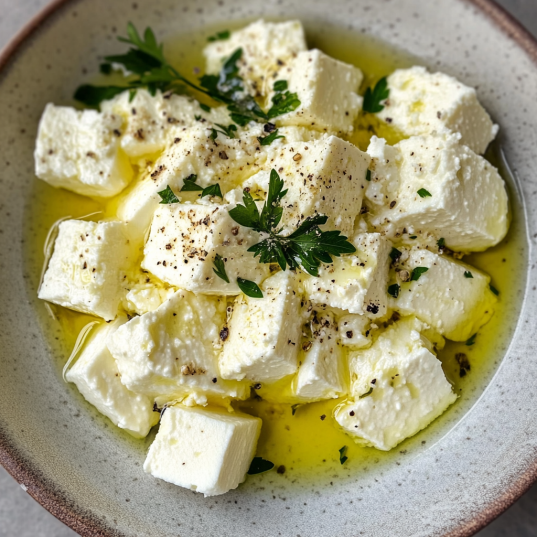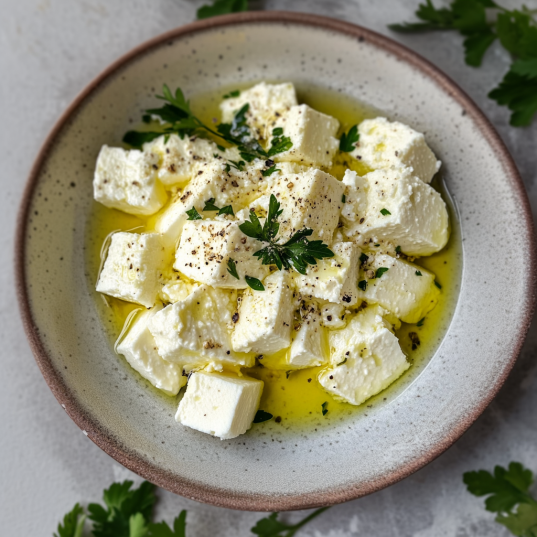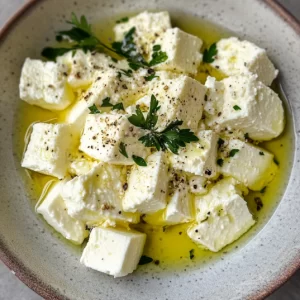Feta cheese, with its creamy texture and tangy flavor, is a beloved ingredient in many Mediterranean dishes. Making your own feta at home is easier than you might think, and it offers a fresher, more customizable option than store-bought varieties. This recipe guides you through the process of making homemade feta cheese using simple ingredients. Perfect for salads, pastas, and meze platters, homemade feta adds a touch of homemade goodness to any dish!

Ingredients
- 1 gallon (4 liters) whole milk (preferably raw or full-fat, not ultra-pasteurized)
- ¼ tsp mesophilic culture (available from cheese-making suppliers)
- ¼ tsp liquid calcium chloride (optional, if using pasteurized milk)
- 1/4 tsp liquid rennet (or 1/4 rennet tablet, dissolved in ¼ cup water)
- 1 tbsp salt
- 1-2 tbsp white vinegar or lemon juice (for acidifying the milk)
- Non-chlorinated water for diluting rennet and calcium chloride
Equipment
- Large stainless steel pot (about 6-8 quart capacity)
- Thermometer
- Cheesecloth
- Cheese mold or a small colander
- Slotted spoon or ladle
- Knife for cutting curds
- Cheese press (optional for firmer feta)
- Large bowl for draining

Instructions
- Heat the milk:
Pour the milk into a large stainless steel pot and slowly heat it over medium heat to 85°F (29°C). Stir occasionally to ensure the milk doesn’t scorch. - Add the culture:
Sprinkle the mesophilic culture over the surface of the milk and let it rehydrate for 1-2 minutes. Then, stir gently to incorporate it into the milk. Allow the milk to sit at 85°F for about 1 hour for the culture to work. - Add the acid:
Add vinegar or lemon juice to the milk and stir gently. This will help the milk acidify, making it ready to form curds. - Add rennet:
Dilute the rennet in a small amount of non-chlorinated water (about ¼ cup) and stir it into the milk. Cover the pot and let it sit undisturbed for 1-2 hours, maintaining the milk temperature at 85°F. The milk should set and form a soft curd. - Cut the curds:
Once the milk has set and the curds have formed, use a long knife to cut the curd into ½-inch cubes. Let the curds rest for about 5 minutes before gently stirring them with a slotted spoon. - Cook the curds:
Slowly heat the curds to 105°F (40°C) over the course of 30-40 minutes, stirring gently every 5 minutes. This will help the curds firm up. Once they reach the target temperature, remove them from the heat. - Drain the curds:
Carefully ladle the curds into a colander lined with cheesecloth, allowing the whey to drain. Let the curds drain for 1-2 hours, or until the whey has mostly drained off. - Press the curds (optional):
If you prefer a firmer feta, you can place the curds into a cheese mold and press them gently to expel more whey. Press the cheese for 6-12 hours, flipping the cheese occasionally to ensure an even texture. - Salt the feta:
Once the cheese has drained and reached the desired consistency, sprinkle the salt evenly over the surface. For a more intense flavor, you can also add herbs like oregano, thyme, or rosemary at this stage. - Age the feta:
Store the feta in a container filled with brine (water and salt) or olive oil in the fridge for 2-3 days to allow the flavors to develop. Feta can also be kept in a simple saltwater brine for up to 1-2 weeks. - Serve:
Once the feta is aged to your liking, remove it from the brine or oil and serve as a topping for salads, roasted vegetables, or in Mediterranean-inspired dishes.
Tips
- Milk quality: Raw or full-fat milk yields the best texture and flavor. If using pasteurized milk, be sure it’s not ultra-pasteurized.
- Cutting curds: Cut the curds evenly to ensure they cook uniformly.
- Brine: Use 1-2 tablespoons of salt per cup of water for the brine, or experiment with flavor infusions by adding herbs like oregano, basil, or garlic.
- Soft feta: If you prefer a softer feta, avoid pressing it for too long, and allow it to retain more moisture.
Making your own feta cheese is a fun and rewarding process that results in a creamy, tangy cheese that adds a rich flavor to any dish. Once you’ve mastered the basics, you can experiment with different herbs and flavorings to make the feta your own. Enjoy it fresh or aged, in salads, dips, or as a topping for your favorite Mediterranean-inspired meals!

Feta Cheese Recipe
Equipment
- Large stainless steel pot (about 6-8 quart capacity)
- Thermometer
- Cheesecloth
- Cheese mold or a small colander
- Slotted spoon or ladle
- Knife for cutting curds
- Cheese press (optional for firmer feta)
- Large bowl for draining
Ingredients
- 1 gallon 4 liters whole milk (preferably raw or full-fat, not ultra-pasteurized)
- ¼ tsp mesophilic culture available from cheese-making suppliers
- ¼ tsp liquid calcium chloride optional, if using pasteurized milk
- 1/4 tsp liquid rennet or 1/4 rennet tablet, dissolved in ¼ cup water
- 1 tbsp salt
- 1-2 tbsp white vinegar or lemon juice for acidifying the milk
- Non-chlorinated water for diluting rennet and calcium chloride
Instructions
- Heat the milk:
- Pour the milk into a large stainless steel pot and slowly heat it over medium heat to 85°F (29°C). Stir occasionally to ensure the milk doesn’t scorch.
- Add the culture:
- Sprinkle the mesophilic culture over the surface of the milk and let it rehydrate for 1-2 minutes. Then, stir gently to incorporate it into the milk. Allow the milk to sit at 85°F for about 1 hour for the culture to work.
- Add the acid:
- Add vinegar or lemon juice to the milk and stir gently. This will help the milk acidify, making it ready to form curds.
- Add rennet:
- Dilute the rennet in a small amount of non-chlorinated water (about ¼ cup) and stir it into the milk. Cover the pot and let it sit undisturbed for 1-2 hours, maintaining the milk temperature at 85°F. The milk should set and form a soft curd.
- Cut the curds:
- Once the milk has set and the curds have formed, use a long knife to cut the curd into ½-inch cubes. Let the curds rest for about 5 minutes before gently stirring them with a slotted spoon.
- Cook the curds:
- Slowly heat the curds to 105°F (40°C) over the course of 30-40 minutes, stirring gently every 5 minutes. This will help the curds firm up. Once they reach the target temperature, remove them from the heat.
- Drain the curds:
- Carefully ladle the curds into a colander lined with cheesecloth, allowing the whey to drain. Let the curds drain for 1-2 hours, or until the whey has mostly drained off.
- Press the curds (optional):
- If you prefer a firmer feta, you can place the curds into a cheese mold and press them gently to expel more whey. Press the cheese for 6-12 hours, flipping the cheese occasionally to ensure an even texture.
- Salt the feta:
- Once the cheese has drained and reached the desired consistency, sprinkle the salt evenly over the surface. For a more intense flavor, you can also add herbs like oregano, thyme, or rosemary at this stage.
- Age the feta:
- Store the feta in a container filled with brine (water and salt) or olive oil in the fridge for 2-3 days to allow the flavors to develop. Feta can also be kept in a simple saltwater brine for up to 1-2 weeks.
- Serve:
- Once the feta is aged to your liking, remove it from the brine or oil and serve as a topping for salads, roasted vegetables, or in Mediterranean-inspired dishes.


Leave a Reply